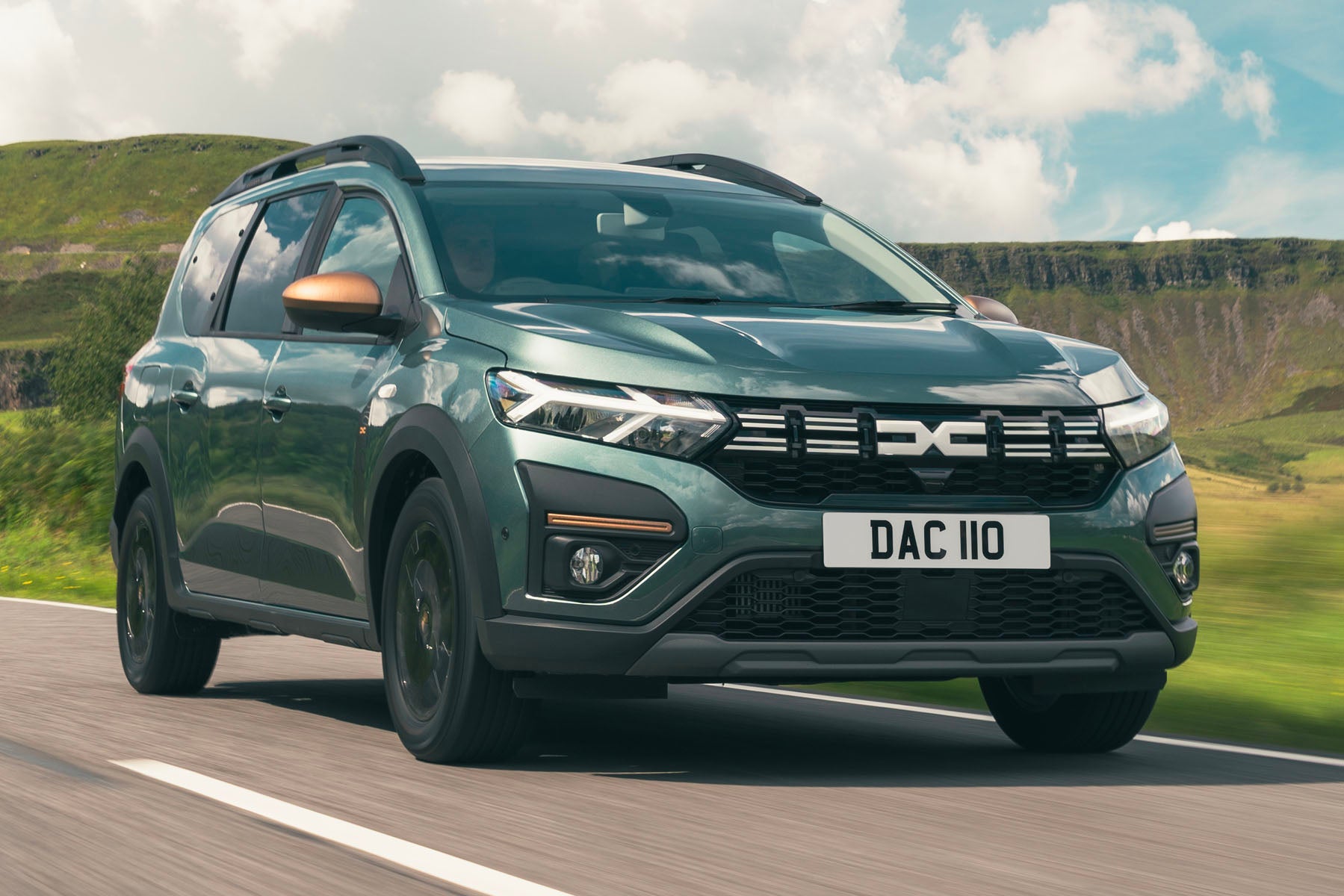Dacia Jogger Review 2025: Price, specs & boot space
Written by Andrew Brady
Quick overview
Pros
- A rare new car bargain
- Removable third row of seats
- Hybrid model is impressive
Cons
- 1.0-litre petrol low on refinement
- Third row of seats only really for occasional use
- Questionable safety record
Verdict: Is the Dacia Jogger a good car?
"The Dacia Jogger is an antidote to the increasingly expensive world we live in. While energy bills, fuel prices and the weekly food shop all are rising in price, the Dacia Jogger is a brand new seven-seater you can buy for less than £20,000."
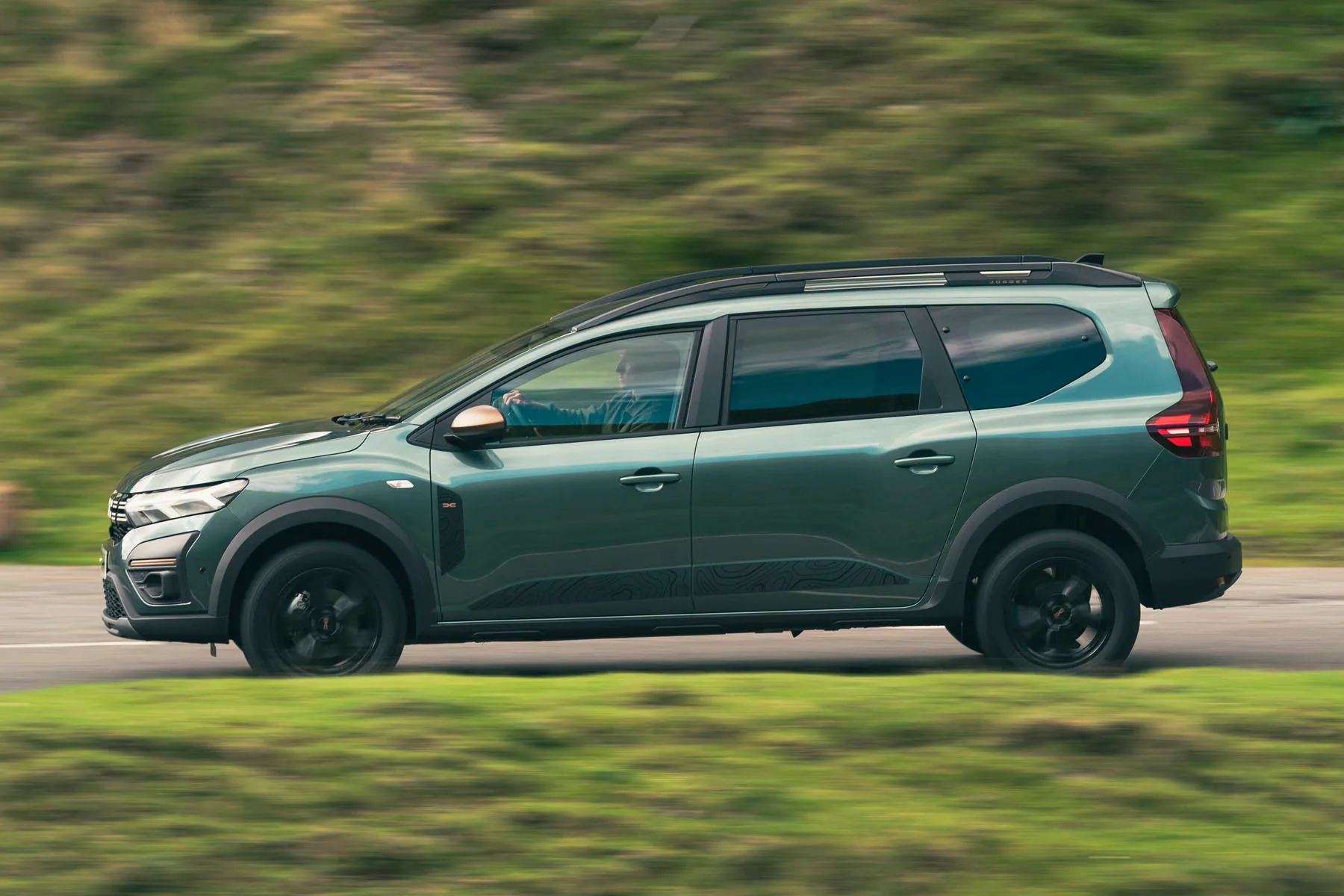
So what is the Dacia Jogger? It's basically an estate version of the Dacia Sandero, with an extended platform providing space (just about) for seven seats. Chuck in a slightly raised ride height and a stepped roofline, and it's also borderline family SUV territory (again, just about).
There's nothing else quite like it on the market, but you could well be looking at it alongside conventional estate cars like the Skoda Octavia Estate or, for used buyers, maybe the electric MG 5 EV. With its sub-£20,000 starting price, though, you're perhaps more likely to be considering this an alternative to a four-year-old Citroen Grand C4 SpaceTourer or Vauxhall Zafira.
The Dacia Jogger line-up is refreshingly simple. You get the choice of just three trim levels: Essential, Expression and Extreme. There are just two engines: a peppy little 1.0-litre that's paired exclusively with a six-speed manual gearbox, or Dacia's 1.6-litre petrol-electric hybrid model.
The majority of buyers will go for the mid-level Dacia Jogger Expression, which comes with 16-inch Atara Flex wheels (they look like alloys but aren't), clever modular roof bars, climate control and an eight-inch media system with Apple CarPlay and Android Auto.
It certainly feels like a budget option inside, where you'll find tough plastics, old-fashioned rotary knobs for the climate control (not necessarily a bad thing...) and – on Expression and Extreme models – the aforementioned eight-inch infotainment system tacked onto the dash like an afterthought. The base Essential model does without infotainment.
It's spacious, though, with room for adults in the second row of seats and enthusiastic children in the third row. You don't get a lot of boot space with all seven seats in use but, fortunately, the two seats in the boot are extremely lightweight and can be removed entirely without much hassle. We'd suggest doing this on a semi-permanent basis – if you need a true seven-seater, look elsewhere.
With a kerb weight of just over 1200kg, the Dacia Jogger's little 1.0-litre engine moves it along quite happily (or it does when the car's not bursting with passengers, anyway). It's quite noisy and unrefined, however, compared to something like a Volkswagen Golf Estate.
While it costs more to buy, the Dacia Jogger Hybrid is our pick of the (limited) line-up. With an extra dollop of power and an automatic gearbox, it's more relaxing to drive than the petrol Jogger. The electric motor means it's surprisingly refined around town or when coasting at higher speeds, while it's also very efficient.
We like the Dacia Jogger. It's a refreshingly affordable new car that goes against the fad for premium-badged SUVs. It's impossible to overemphasise how remarkably good value it is – it's a seven-seat estate car for the price of a used Ford Fiesta. But it has other talents, too, including impressive versatility and a choice of eager engines. Sure, there are a few hard plastics in the cabin and a bit more soundproofing wouldn't go amiss, but the Jogger's a genuine new car bargain.
Looking for a used car for sale? We've got 100s of Dacia Approved Used Cars for Sale for you to choose from, including a wide range of Dacia Jogger models for sale.
Is the Dacia Jogger right for you?
If you're looking for an unpretentious family car that you won't feel bad about loading with children or chucking a muddy mountain bike into the back of, the Dacia Jogger could be the ideal choice. If you really need a seven-seater, you might need to look at bigger (pricier) alternatives, but the affordable Dacia is surprisingly practical.
What's the best Dacia Jogger model/engine to choose?
This depends on your budget. The 1.0-litre petrol engine is pretty good, although we think the extra refinement and efficiency provided by the hybrid model makes it easier to recommend.
The Dacia Jogger Essential is incredibly basic and the novelty of owning a car without air conditioning could soon wear off. With that in mind, it's worth stretching at least to the mid-spec Jogger Expression with features such as an infotainment system, cruise control and a reversing camera.
And once you've justified that extra cash, it's only an extra £1,000 for the top-spec Dacia Jogger Extreme. This is the model we'd go for - with its heated seats, alloy wheels and upgraded sound system. Yes, buying the most expensive version of a budget car might not sound particularly logical, but it's still only a shade more than £24,000 with the hybrid powertrain.
What other cars are similar to the Dacia Jogger?
If you're looking for a sensible hybrid estate, we'd recommend the Toyota Corolla Touring Sports as an alternative to the Dacia Jogger. It's not quite as versatile as the Jogger, while it's also more expensive. That said, you can pick up a used example for sensible money - and Toyota's impressive warranty and strong reliability record make it a sensible long-term purchase.
The electric-only MG 5 is an impressive budget estate car, while you should also look at more conventional (and more expensive) alternatives like the Ford Focus Estate and Skoda Octavia Estate. Family SUVs like the Nissan Qashqai and Kia Sportage are more fashionable but considerably more expensive, while those seeking practicality on a budget should consider used van-based people carriers like the Peugeot Rifter and Citroen Berlingo.
Comfort and design: Dacia Jogger interior
"While the Dacia Jogger is quite innovative in many ways, it's pretty ordinary inside. It looks and feels just like a Dacia Sandero, which means it's functional rather than fancy."

Still, the Dacia Jogger will appeal to buyers who don't want all the latest technology and highfalutin (read: irritating) touch-sensitive climate control buttons. The most basic Dacia Jogger Essential doesn't even come with an infotainment screen – it's got a phone holder instead.
It's just a very easy cabin to get used to. The seats are supportive, although don't expect things like electric adjustment or lumbar support. You do sit higher than in a regular hatchback, but you're not going to be towering over other motorists.
There are a few highlights which mean the Jogger's cabin isn't too drab an affair. We like the fabric running along the width of the dash, for example, and the angular air vents are a neat touch.
Quality and finish
There's certainly little in the way of plushness in the Dacia Jogger, but it's unashamedly a budget car. There are plenty of hard plastics around the cabin, particularly on the door cards and around the centre console. It feels like it'll take whatever family life throws at it and. for the price, the Dacia Jogger is perfectly well built.
Infotainment: Touchscreen, USB, nav and stereo in the Dacia Jogger
Each of the Dacia Jogger's three trim levels comes with a slightly different infotainment offering.
The Dacia Jogger Essential comes with a Media Control System, which is essentially just a phone holder attached to the dashboard. You can download Dacia's Media Control app and pair your phone to the car's in-built media system via Bluetooth. This allows you to play music and navigation instructions through the car's speakers, while your phone acts as the display for your own nav system (Google Maps, for example). There's a lot to be said for a system like this, especially if you're planning to keep the car for a long time - its simplicity means it'll age better than more complex infotainment systems.
The Media Display system is standard on the Dacia Jogger Comfort and adds an eight-inch touchscreen display mounted high on the dashboard and angled towards the driver. You still get the in-built phone holder but it isn't strictly necessary as Android Auto and Apple CarPlay are also standard. It's an easy system to use, although its slightly tardy responses and 'tacked onto the dashboard' positioning means it does have a cheap Android tablet feel about it.
Top-spec Dacia Jogger Extreme models use the same eight-inch display with added wireless connectivity for Android Auto and Apple CarPlay as well as an upgraded six-speaker audio system and in-built navigation. While we haven't sampled this system, we suspect it might be worth the extra cash - the four-speaker sound system fitted to lesser models isn't particularly punchy.
Space and practicality: Dacia Jogger boot space
Measuring 4547mm long and 2007mm wide (including door mirrors), the Dacia Jogger's external dimensions are similar to a Volkswagen Golf Estate.
It's cleverly packaged, so it feels surprisingly spacious for its relatively compact footprint. You get a lengthy wheelbase, which means the wheels are pushed out to each corner so that they don't intrude on interior space. You also get a stepped roof which means there's loads of headroom inside.
Certainly, space in the front is more than adequate. You don't get a high seating position (like in an SUV alternative like the Skoda Karoq), but there's enough room for a pair of adults without any awkward elbow bashing. Large wide windows and that stepped roof mean it doesn't feel claustrophobic in the second row of seats, either, although adults will find their knees brushing the front seats.
The third row of seats are only really for occasional use. With them, there's just 212-litres of boot space. Simply getting into them requires a fair amount of agility - kids will embrace the challenge, no doubt, but adults will struggle.
Fortunately, the rear-most seats are surprisingly lightweight and easily lifted out. You can't buy a five-seat Dacia Jogger in the UK, but we suspect many buyers will store the back seats away in the garage most of the time. With them removed, there's 699 litres of boot space available, which is even more than a Skoda Octavia Estate. Access is easy, too, thanks to a low loading lip and a wide boot opening. Tip all of the rear seats flat and you can free up a very impressive 2085-litres of maximum carrying capacity.
One feature of note is the clever modular roof rails which, with the help of an Allen key can be turned into a full roof rack capable of carrying up to 80kg (ideal for fixing a roof box when the car's full up with passengers). These are standard on Dacia Jogger Expression and Extreme models.
Handling and ride quality: What is the Dacia Jogger like to drive?
"The Dacia Jogger rides decently thanks to its standard-fit 16-inch wheels and supple suspension. Sure, it's not got the most sophisticated ride, but it's certainly no less comfortable than van-based people carrier alternatives."
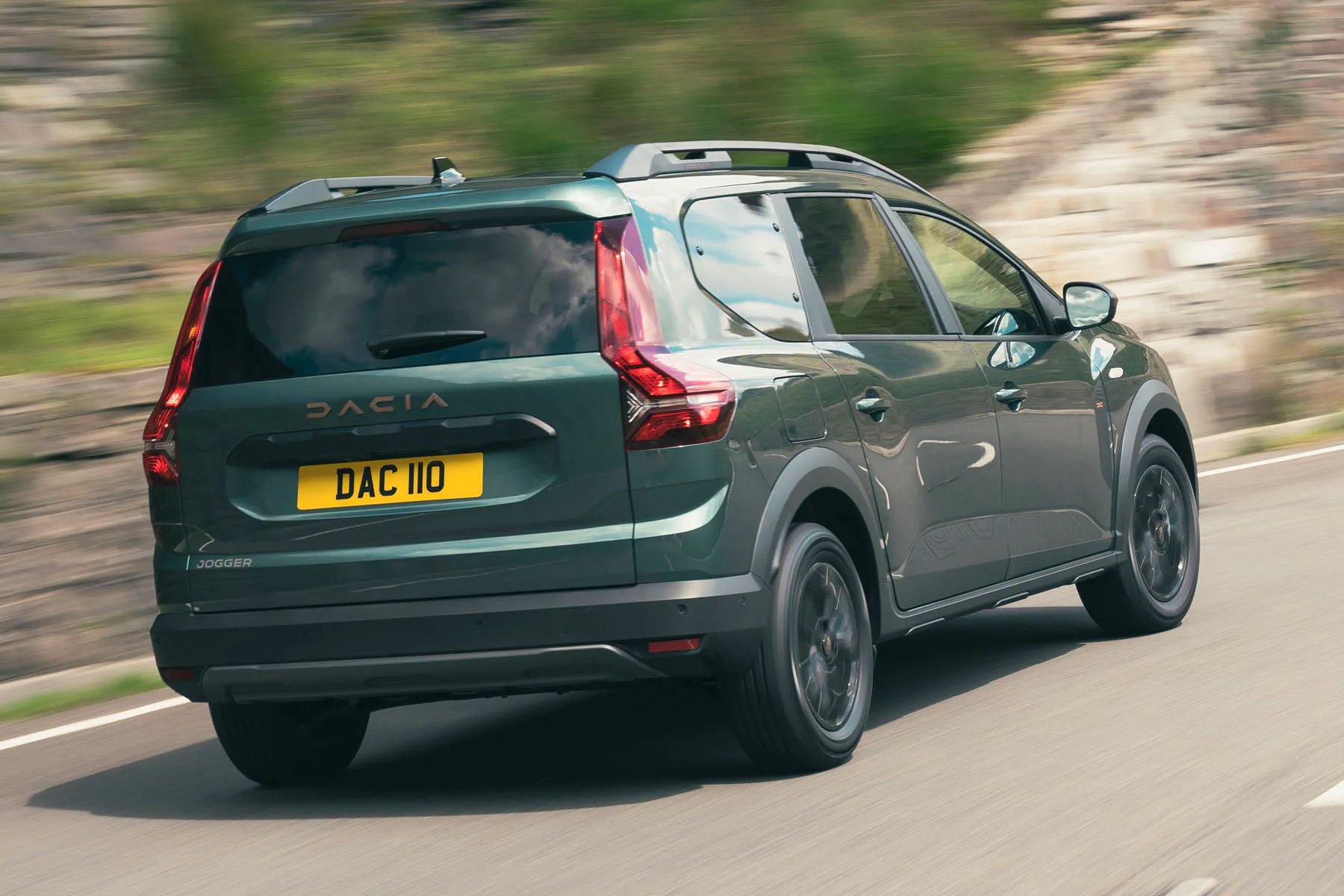
The Dacia Jogger is so versatile that it's easy to forget it's got a smaller footprint than a Ford Focus Estate, which helps when you need to tackle a narrow lane or congested car park. Rear parking sensors are standard across the range, while Expression and Extreme models also come with them at the front as well as a reversing camera. If you've got a tight driveway, the Dacia Jogger is a much better option than a traditional people carrier such as the Volkswagen Touran.
Out of town, the Dacia Jogger isn't exactly a sharp handler, but there's plenty of grip available and it doesn't feel like a boat in corners. It's a shame that Dacia doesn't offer the Jogger with four-wheel drive, although that would be an extra expense and complexity that few buyers would really want. The top-spec Dacia Jogger Extreme does come with an Extended Grip function which tweaks the power going between the front wheels. This provides a little more control in slippery conditions.
What engines and gearboxes are available in the Dacia Jogger?
There are two engines available in the Dacia Jogger. The first is a 1.0-litre turbocharged petrol engine badged the TCe 110. It's not particularly powerful, with 110PS and 200NM of torque. As the Jogger weighs just 1205kg (barely any more than the latest Mazda MX-5), it's surprisingly sprightly - we reckon it feels quicker than its official 11.2 second 0-62mph time suggests. The six-speed manual gearbox, meanwhile, is precise enough while the clutch action is light.
Our engine of choice in the Dacia Jogger, though, is the hybrid. This pairs a bigger 1.6-litre petrol engine with an electric motor, providing a total power output of 140PS and 148Nm of torque. It'll accelerate to 62mph in 10.0 seconds flat - again, not especially quick, but it's fast enough to keep up with motorway traffic and you get an automatic gearbox as standard.
Refinement and noise levels
If there's one area in which you can really tell the Dacia Jogger is a budget car, it's here. Like most little three-cylinder engines, the TCe 110 is quite a grumbly little unit. There's not as much sound insulation as you'd get in more expensive alternatives so things get pretty noisy when you build the revs. It's quite characterful in some ways, but it soon gets boring.
There's also a considerable amount of wind and road noise at speed, too. It's not the kind of car that'll isolate you from your surroundings after a long day at work.
The Jogger Hybrid is more refined, especially at town speeds where it'll bimble about with the petrol engine barely kicking in. You'll notice a bit of a roar from the engine under heavy acceleration, but there's enough power available that full-throttle getaways are rarely necessary.
Safety equipment: How safe is the Dacia Jogger?
All Dacia Jogger models feature six airbags as well as a range of advanced driver assistance systems (ADAS). These include an automatic emergency braking system that uses front-mounted radar to detect an impending collision with the vehicle ahead and can alert the driver or apply the brakes to prevent a potential collision.
For the upper two trims, there's also a blind spot warning system in the form of a light within the door mirror to notify you of cars in your blind spot, while all models come with rear parking sensors to help prevent a collision when parking. The Dacia Jogger Expression and Extreme also come with front parking sensors and a rear-view camera.
The Dacia Jogger was awarded a pretty dismal one star when it was crash-tested by Euro NCAP. Don't dismiss it for this reason straight away – it performed relatively well for its protection of both adult and child occupants. Most of NCAP's criticism was aimed at the Jogger's poor pedestrian protection and its lack of autonomous safety systems (things like lane-keeping assist – the kind of thing many of us turn off, anyway).
MPG and fuel costs: What does a Dacia Jogger cost to run?
"According to WLTP tests, the petrol Dacia Jogger returns up to 48.7mpg with the 1.0-litre petrol engine. Like most small-capacity turbocharged engines, its real-world economy will take a hit if you try to extract the most performance out of it, but it should be fairly efficient under day-to-day driving. With a 50-litre fuel tank, expect to fill the Jogger up every 400 miles or so."
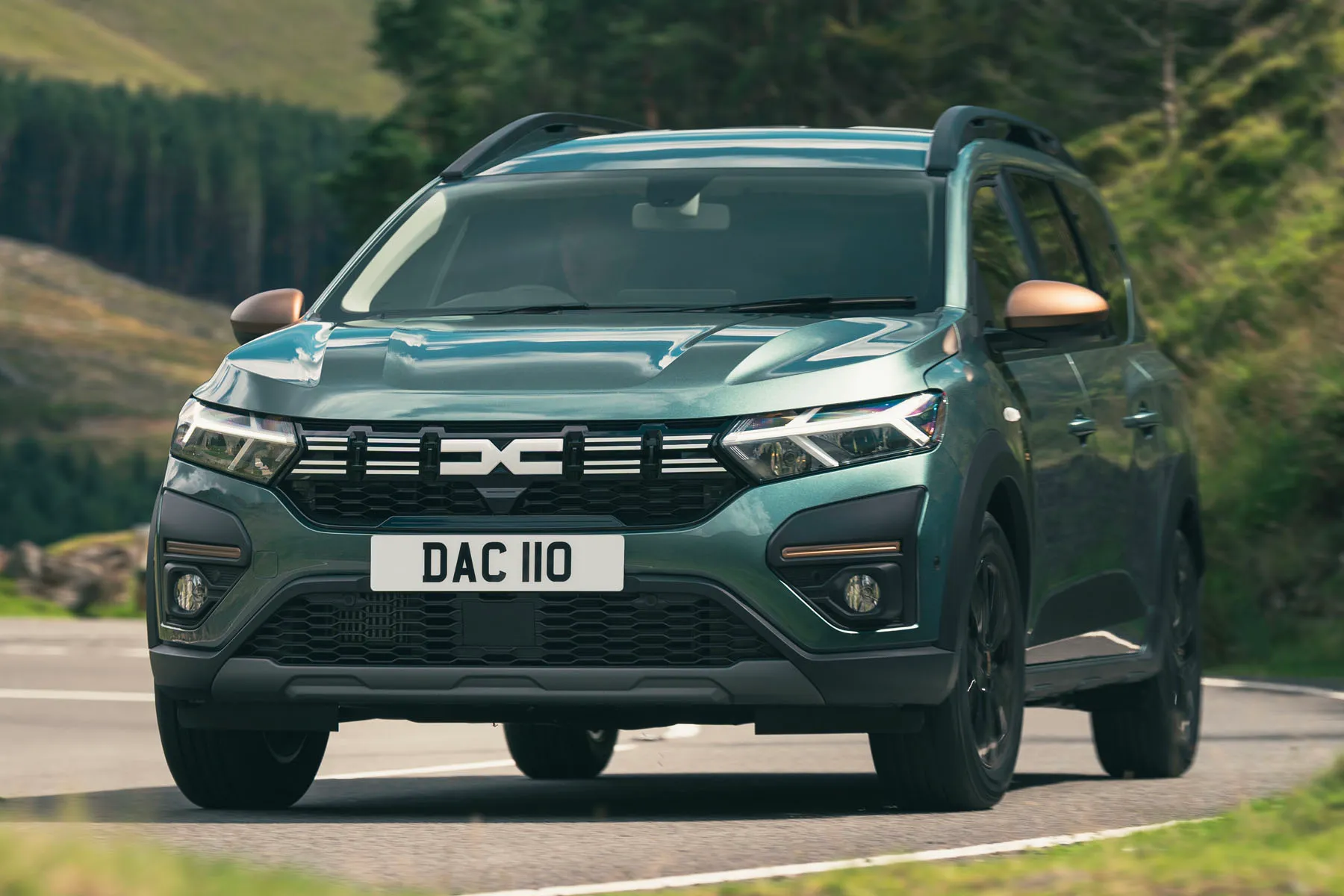
Dacia has no plans to introduce a diesel Jogger, leaving the hybrid model to cater for those seeking greater efficiency. While it can't travel any great distance under electric power alone, the hybrid setup helps improve the Jogger's real-world fuel economy. Officially it'll return up to 58.9mpg - we were surprised to see an average of around 52.0mpg during a week of combined driving. That's pretty good for a car of this size.
Dacia Jogger reliability and warranty
Dacia might be a budget car brand but that doesn't mean it's going to leave you stranded on the side of the road. The manufacturer actually came 14th in the latest HonestJohn.co.uk Satisfaction Index, with owners happier with their cars than the likes of Volkswagen or Mazda. We have received a few reports of clutch issues with the 1.0-litre engine, though - perhaps a good reason to upgrade to the hybrid model.
Dacia Sandero insurance groups and costs
Petrol Dacia Jogger Essential and Comfort models have been placed into insurance group 13, while the Dacia Jogger Extreme is in insurance group 14 for the 1.0-litre model, with the Hybrid in group 15 or 16 depending on trim level. That means it'll cost roughly the same as a base-spec Ford Focus Estate to insure.
VED car tax: What is the annual road tax on a Dacia Jogger?
The standard petrol Dacia Jogger will cost a flat rate of £195/year to tax, which is the same as all non-hybrid or electric alternatives. For new buyers, the first year's road tax is £390 for the hybrid version and £540 for the 1.0-litre petrol model.
Dacia Jogger price
"Whether you're buying new or used, the Dacia Jogger represents remarkable value for money. A budget of just £15,000 will get you a nearly-new Dacia Jogger with the 1.0-litre petrol engine - that's cheaper than some small city cars."
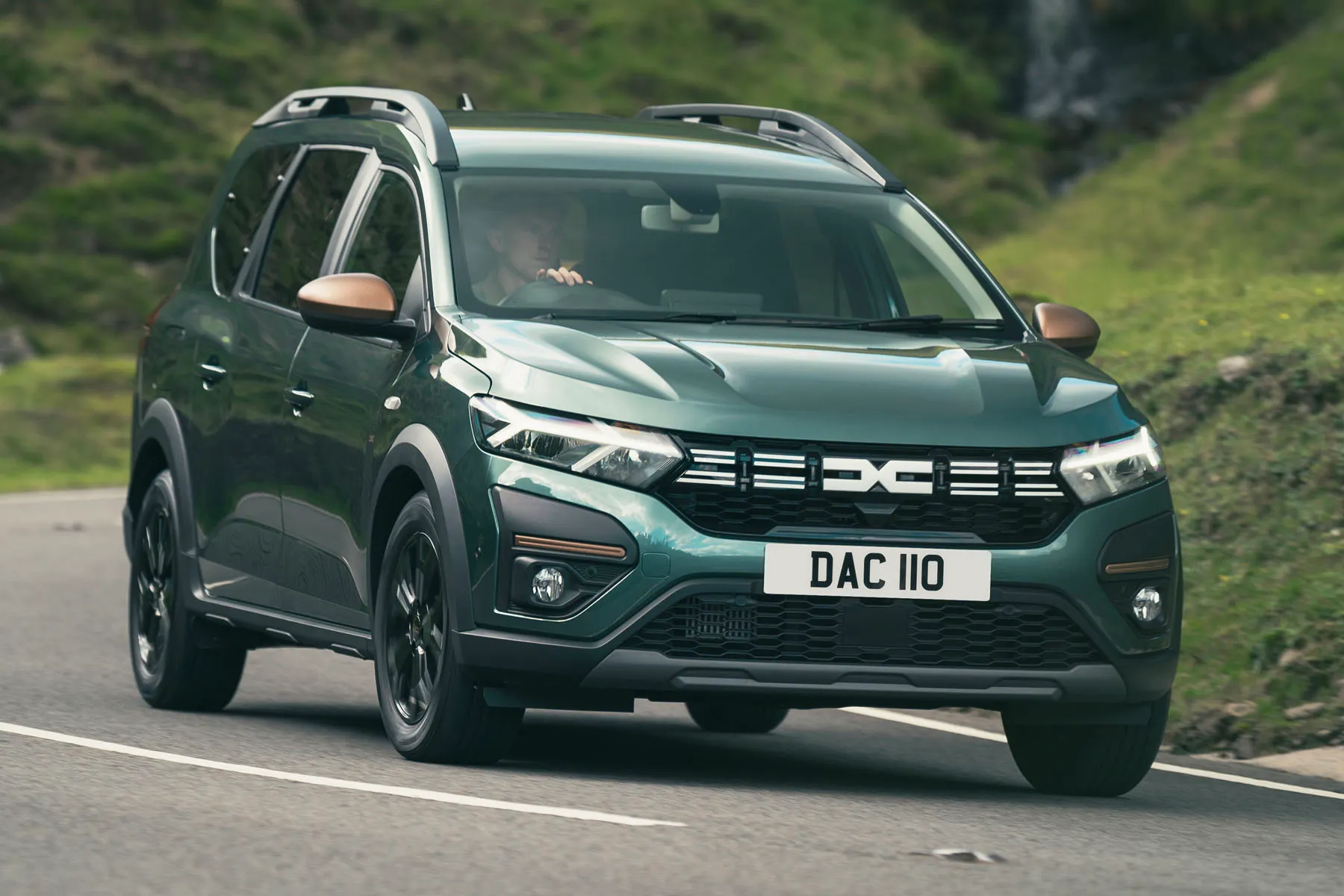
The cheapest Dacia Jogger you can buy is the Essential trim, which starts from a little less than £19,000 with the petrol engine. Budget around £20,000 for the mid-spec Expression, while the top-of-the-range Dacia Jogger Extreme is another £1,000 on top of that.
We prefer the Dacia Jogger Hybrid, although it's more expensive to buy than the petrol model. It's not been on sale as long, either, so it's more difficult to save cash by hunting one out on the used market. Dacia Jogger Hybrid prices start from £23,305 in Expression trim, while the top-spec Extreme is a further £1000 on top of that. That's around £8,000 less than an entry-level Toyota Corolla Touring Sports.
It's not like you need to look for one with an extensive list of options, either. The only optional extras you can buy are metallic paint (£650) and - on petrol models - a spare wheel (£300). On top of that, Dacia offers a wide range of accessories such as a removable tow bar, dashcam and even a camping pack for sleeping in your car.
Trim levels and standard equipment
As its name suggests, the Dacia Jogger Essential covers the basics. Standard equipment includes manual air conditioning, rear parking sensors, cruise control and automatic headlights. You get a steering wheel that adjusts for height and reach, electric front windows, an automatic emergency braking system and Dacia’s Media Control system in place of a modern infotainment display.
The Dacia Jogger Expression (initially badged Comfort) adds modular roof rails, body-coloured door handles, front and rear parking sensors with a reversing camera, 16-inch ‘Flex’ steel wheels which look a bit like alloys and electrically adjustable and heated door mirrors. Inside, the Jogger Expression comes with a soft-feel steering wheel, chrome and copper orange interior highlights, a central armrest, electric rear windows, an electronic parking brake, keyless entry, automatic air conditioning, blind spot warning, automatic wipers, and Dacia’s eight-inch infotainment system with Apple CarPlay/Android Auto.
The Dacia Jogger Extreme tops the range with 16-inch black alloy wheels along with matching black roof bars and door mirrors. Inside, the Jogger Extreme comes with heated front seats, special floor and cargo mats and a built-in navigation system.
Ask the heycar experts: common questions
Why is the Dacia Jogger so cheap?
Where is the Dacia Jogger made?
How much is the Dacia Jogger?
Get our latest advice, news and offers
Keep me updated by email with the latest advice, news and offers from heycar.
By submitting you agree to our privacy policy
